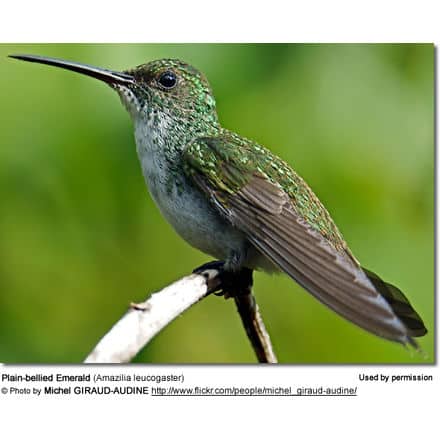Chestnut-sided Warbler
The Chestnut-sided Warblers (Dendroica pensylvanica) are migratory songbirds that breed in eastern North America from southern Canada southward through the Appalachian mountains to Georgia.
Some populations also occur from extreme southern Illinois south parts of Missouri and Arkansas; as well as eastern Iowa and northern Ohio.
These migratory birds winter in Central America south to northern Colombia, with high concentrations found in Costa Rica.. They are rare vagrants to western Europe.
Description
The Chestnut-sided Warbler averages 4.25 inches in length, including its tail.
can easily be distinguished from any other warbler – as no other warbler combines a greenish-yellow cap, a white chest and reddish streaks down its sides.
The summer plumage (also referred to as “Breeding plumage”) of the male Chestnut-sided Warblers consists of a dark-streaked grey upper plumage with two white wing bars; and a mostly white under plumage, with chestnut flanks. They have white faces, greenish-yellow cap (foreheads), black eyestripes and greenish crowns (top of the head).
The adult females looks like a duller version of the summer male. She lacks the strong head pattern, and she also have less chestnut-coloring on their flanks.
Non-breeding birds look alike. Both males and females have greenish heads and upper plumage, which are usually unstreaked. Their chest is an unstreaked grey. They wing bars are always present (winter or summer plumage).
Juvenile birds look like the “fall”, non-breeding adult, but they have finer streaks, white abdomens and undertail coverts (feathers). Some rust may be seen on the sides. They have white eye rings. Juvenile females lack the chestnut on the sides.
Similar species: Outside the breeding season, the look similar to the Blackpoll Warbler – but can be distinguished by their lack of streaking. The Bay-breasted Warblers also has chestnut sides, but the breeding male has a dark face, and the throat and crown are chestnut. The non-breeding male or female Bay-breasted is dusky underneath and lacks the bright yellow-green of a Chestnut-sided Warbler.
Calls / Vocalization
The males use two song types; one being a whistled pleased, pleased, pleased to meecha – which is mostly used to attract females and early in the breeding season.
Another call consists of harsh chips; may be used in territorial encounters with other males.
Breeding / Nesting
The nest sites are selected by the females and is usually situated in shrubby, deciduous understories close to the ground. The loosely woven cup nest is constructed by the female using a variety of plant parts, such as bark strips, shredded weed stems, grasses, plant down, sedges and rootlets.
The average egg size consists of 3 to 5 eggs, which are incubated by the female alone.
Diet / Feeding
Chestnut-sided Warblers mostly eat insects, as well as foraging for berries particularly during the winters.



